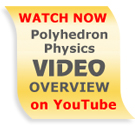
Polyhedron Physics+ is a remarkably realistic collection of simulated physics laboratory equipment and data collection tools. 24 iOS iPad apps for high school level physics have everything you need to conduct physics laboratory experiments. 3D simulations that produce realistic data, PLUS introductory videos, background theory, experimental procedures, and analysis and reporting tools. Teacher support materials include Post-lab Quizzes, Questions with sample answers, and sample Lab Reports. Polyhedron Physics + is an ideal option when hands-on lab equipment is not available, and when remote learning is desirable or essential.
TEACHER SUPPORT MATERIALS
Physics Lab Simulations
Vision Science Lab Simulations
|
|
NEWTON’S SECOND LAW OF MOTION Use a laboratory cart to investigate the relationships between the force applied to an object and the mass and acceleration of the object. |
ACCELERATION OF GRAVITY Use a position sensor to examine the relationship between the position, velocity, and acceleration of a free-falling body. |
ADDITION OF FORCE VECTORS Use a force table to investigate the vector addition of forces. |
ARCHIMEDES’ PRINCIPLE Use a laboratory balance, metal samples, water, and alcohol to investigate Archimedes’ Principle, and to determine the mass densities of solids and fluids. |
||
|
CENTRIPETAL FORCE Use a centripetal force apparatus to investigate the relationships between the centripetal force on an object and the mass, velocity, and radius of revolution of the object. |
CONSERVATION OF ENERGY Use a spring-mass system to investigate the conservation of mechanical energy. |
CONSERVATION OF MOMENTUM Use two colliding bodies to investigate elastic and inelastic collisions, and compare kinetic energy. |
FRICTION Use a friction block to determine the coefficients of static friction and kinetic friction for two surfaces in contact. |
||
|
GAS LAWS Use a syringe, masses, a thermometer, a hotplate, and a water and ice bath to investigate Boyle’s Law and Charles’s Law. |
HOOKE'S LAW Use a spring-mass system to investigate the relationship between the force acting on a spring and the resulting change in length of the spring. |
IMAGE FORMATION USING LENSES Use an optical bench to determine the focal length of a converging lens and to investigate the relationship between the object distance and the image distance. |
JOULE HEATING Use a calorimeter to investigate electrical energy and thermal energy. |
||
|
MOMENTUM AND IMPULSE Use a laboratory cart to investigate the relationship between the impulse exerted on a constant mass and the resulting change in the momentum of the mass. |
MOTION OF A PENDULUM Use a mass on a string to investigate the relationships between the mass, length, amplitude, and period of oscillation of a pendulum. |
OHM’S LAW Use a resistor, a power supply, a voltmeter, and an ammeter to investigate the relationships between the voltage, current, and resistance in a circuit. |
RC CIRCUITS Use a power supply, voltmeters, capacitors, and resistors to investigate RC circuits. |
||
|
REFLECTION OF LIGHT Use a plane mirror to investigate the relationships between object and image distances and angles of incidence and reflection. |
REFRACTION OF LIGHT Use a refraction cell and a ray box to investigate Snell’s Law of Refraction, total internal reflection, and the critical angle of refraction. |
SERIES AND PARALLEL CIRCUITS Use resistors, a power supply, a voltmeter, and an ammeter to investigate the effective resistances of circuits with resistors in series, in parallel, and in combinations of series and parallel components. |
SIMPLE HARMONIC MOTION Use a spring-mass system to investigate relationships between the spring constant, mass, amplitude of oscillation, and period of oscillation for a mass on a spring. |
||
|
SPECIFIC HEAT OF A METAL Use a calorimeter to measure the specific heat of a metal. |
SPEED OF SOUND Use a resonance chamber to measure the wavelength of a sound wave, and determine an experimental value for the speed of sound in air. |
WORK AND ENERGY USING AN ELECTRIC MOTOR Use an electric motor and other equipment to investigate energy efficiency. |
WORK AND MECHANICAL ENERGY Use a laboratory cart to investigate the relationship between the work done on an object and the change in kinetic energy of the object. |
||
|
|||||


Copyright © 2025 by Polyhedron Learning Media, Inc. All rights reserved.
Partial funding for this project was provided under contract number ED-IES-11-C-0029 by the Institute of Education Sciences
in the U.S. Department of Education through the Small Business Innovation Research (SBIR) program.
